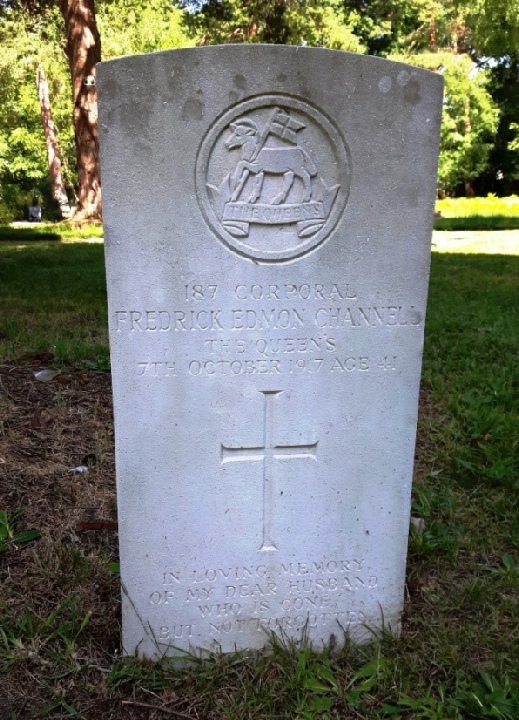

© John Clarke 2014-
John Clarke
Historian of Brookwood Cemetery

Corporal Frederick Edmon Channell
Corporal Frederick Edmon Channell was killed by the Army 12 stone champion in a tragedy at Sittingbourne.

The tragic events of Corporal Channell’s death took place on the evening of 7 October 1917. Three soldiers, walking from the “King’s Head”, Chalkwell, Milton, towards Sittingbourner, after closing time, were singing and making a noise on the way. Corporal Channell, of the Queen’s Royal West Surrey Regiment, who was accompanied by two civilians, spoke to the men and asked them to stop their noise and go home quietly. One of the three soldiers, Private William Mahurter, of the Transport Workers Battalion, Bedfordhsire Regiment, who was working at Ridham Dock, resented the Corporal’s action, and spoke to him about it. A few words passed -
Corporal Channell, who was 40 years old, was a Woking man, and had been with the Queen’s Regiments ever since the battalion was based at Sittingbourne. He was the son of William Channell of Chapel Grove, Addlestone; and husband of Margaret Amy Channell of West Street, Woking. He was the father of eight children. In civilian life he was a coal carmen.
Private Mahurter gave himself up to the police and was placed under arrest. An enquiry into the whole incident took place before the County Coroner, Mr c. B. Harris, and a jury on the following Tuesday afternoon (10 August) at the Sittingbourne Police Court. At the conclusion of the inquest the Coroner reviewed the evidence for the benefit of the jury, the main points to consider being first, were they satisfied that Corporal Channell came to his death from haemorrhage of the brain, caused by a fall as the result of a blow? Secondly, if they were of the opinion that Mahurter gave that blow, and if they came to the conclusion that it was Mahurter’s intention to do the deceased grievous bodily harm , that would be murder. On the other hand, if they thought the deceased came to his death as the result of a blow given in irritation, in consequence of having been checked -
After a lengthy consideration, the jury returned to the court and returned a verdict of manslaughter, and Mahurter was committed to the Kent Assizes for trial.
William Mahurter’s trial was heard at the Kent Assizes on 30 November 1917. He admitted he was drunk at the time of the incident, having been drinking rum during the course of the evening. His counsel told the court that he had been fighting in France and had been wounded several times. He had a good character in the Army. Mahurter was sentenced to six weeks’ hard labour. One local newspaper headline noted “RUM DID IT -
Corporal Channell’s CWGC headstone in Brookwood Cemetery reads:
187 CORPORAL
FREDERICK EDMON CHANNELL
THE QUEEN’S
7TH OCTOBER 1917 age 41 [sic]
IN LOVING MEMORY
OF MY DEAR HUSBAND
WHO IS GONE
BUT NOT FORGOTTEN
Copyright © 2018 by John M. Clarke All Rights Reserved